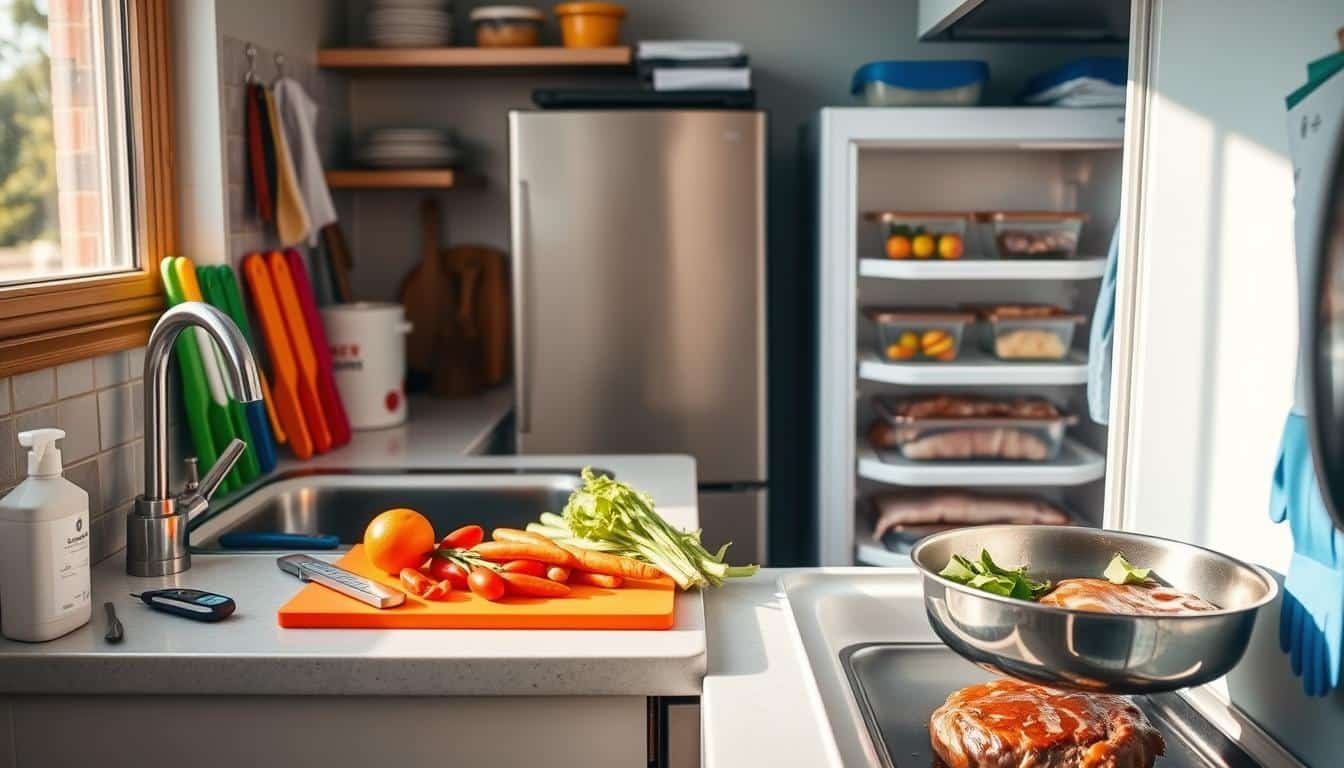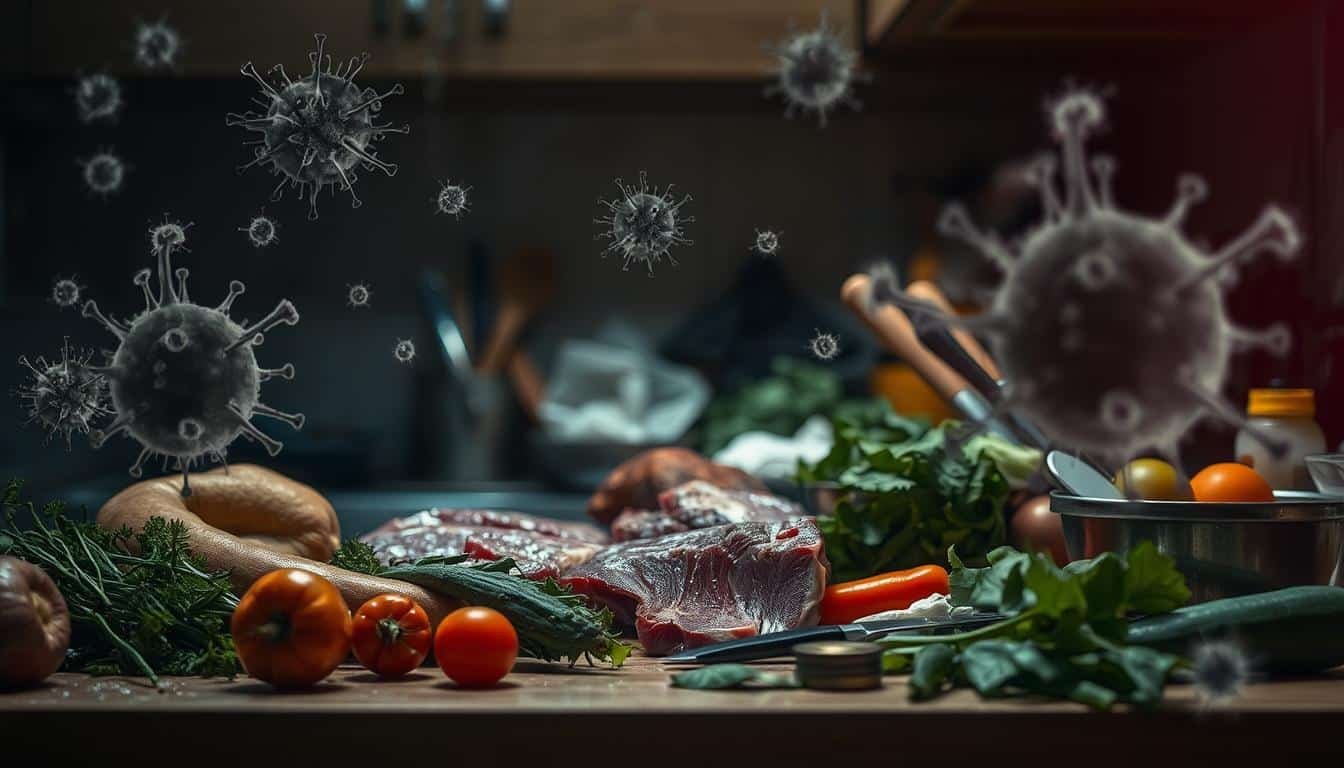Food is our main source of nourishment. It gives us the energy and nutrients we need. But, if food is not handled, prepared, or cooked right, it can be dangerous.
Every year, over 48 million Americans get foodborne illnesses. About 128,000 people end up in the hospital because of this. These illnesses can be very costly and dangerous for both consumers and those who provide the food.
It’s important to prevent foodborne illnesses to keep everyone safe. These diseases can harm our bodies in many ways. They can cause nausea, headaches, fever, and even chronic health problems.
A team that knows how to keep food clean can lower the risk of these illnesses. This way, they can make sure everyone gets a safe and quality meal.
Key Takeaways
- Foodborne illnesses affect millions of Americans every year, leading to hospitalizations and possible long-term health issues.
- It’s crucial to handle, prepare, and cook food correctly to stop the spread of foodborne diseases.
- Keeping food safe in the kitchen is key to protecting consumers’ health and well-being.
- Good food sanitation practices can reduce the risks of foodborne illnesses.
- Ensuring a safe and quality dining experience for everyone is the main goal in food safety.
Also Read : Health Benefits Of A Vegetarian Food Diet
Understanding Food Safety
Keeping food safe is key to stopping foodborne illnesses and keeping people healthy. These illnesses come from eating foods or drinks that are contaminated. They can be caused by bacteria, viruses, parasites, or chemical substances. This can lead to public health risks and food safety emergencies.
Also Read : Easy Healthy Breakfast Recipes
What is Foodborne Illness?
Foodborne illnesses happen when people get sick from eating contaminated food or drink. These illnesses can be mild or very serious. They can come from microbiological agents or chemical substances in food.
Causes and Consequences of Foodborne Diseases
Every year, 600 million people get sick from foodborne diseases, and 420,000 die. These illnesses can lead to the loss of 33 million healthy life years (DALYs). They hit infants and children in poor countries the hardest. The cost of these illnesses is hard to measure because many cases go unreported.
Also Read : Delicious Vegetarian Food Recipes To Every Day
“Foodborne diseases can pose significant public health threats and lead to food safety emergencies that require coordinated global strategies and the implementation of the Codex Alimentarius standards.”
Food Safety

Keeping food safe is a big deal for public health. Around the world, groups like the World Health Organization (WHO), the Food and Agriculture Organization (FAO), and the International Food Safety Authorities Network (INFOSAN) help countries make sure food is safe and healthy. They work on building strong systems, making laws, and giving advice to keep food safe.
Also Read : The Impact Of Fast Food On Health
In the U.S., the government helps with food safety through agencies like the U.S. Department of Agriculture’s Food Safety and Inspection Service (FSIS). They offer tips and resources to stop food illnesses and keep people healthy. These tips cover how to handle and store food right, and how to clean and sanitize properly.
The U.S. Food and Drug Administration (FDA) is also key in keeping food safe. They check most of the food supply to make sure it meets federal standards. The FDA also works on stopping food threats and responding quickly if there’s a safety issue.
World Food Safety Day, on June 7th every year, reminds us how important food safety is. The WHO and FAO organize this day to make people aware and take action against food risks. It’s all about keeping people safe and healthy around the world.
Also Read : How Can You Manage Stress During Exam?
| Organization | Role in Food Safety |
|---|---|
| World Health Organization (WHO) | Works with countries to make and follow food safety rules and laws |
| Food and Agriculture Organization (FAO) | Helps countries build strong food safety systems and gives technical help |
| International Food Safety Authorities Network (INFOSAN) | Shares food safety info and helps coordinate quick responses to emergencies |
| U.S. Department of Agriculture’s Food Safety and Inspection Service (FSIS) | Checks the safety and labels of meat, poultry, and eggs in the U.S. |
| U.S. Food and Drug Administration (FDA) | Keeps an eye on the safety and quality of most of the country’s food |
By working together globally, nationally, and locally, we can make sure our food is safe and healthy. This helps everyone stay healthy and well.
Handling Food Safely

Keeping food safe in the kitchen is key to avoid harmful bacteria and foodborne illnesses. Good food handling is vital for the safety and quality of our food.
Washing Hands and Keeping Clean
Washing your hands is a basic step in food safety. Use warm water and soap for at least 20 seconds before and during food prep. This keeps harmful bacteria away and prevents foodborne illnesses.
Preventing Cross-Contamination
Stopping cross-contamination is crucial in food handling. Use separate cutting boards and knives for raw and cooked foods. This stops harmful bacteria from moving from one food to another, lowering the risk of foodborne diseases.
Proper Cooking and Storage Temperatures
Make sure foods are cooked to a safe temperature and stored right. Keep perishables below 41°F or above 135°F to stop dangerous bacteria from growing. Follow food labeling and regulatory compliance like HACCP to make food handling safer.
“Proper food handling is the foundation of a safe and healthy kitchen.”
Following these food handling tips helps avoid cross-contamination. It ensures cooking and storage temperatures are right. This makes your kitchen safer for everyone.
Five Keys to Safer Food

Keeping food safe is key for our health and well-being. The World Health Organization (WHO) has outlined five main steps to stop foodborne illnesses. By following these steps, we can make our food safer and more nutritious.
- Keep Clean – Washing hands, surfaces, and utensils often gets rid of harmful bacteria and stops them from spreading.
- Separate Raw and Cooked – Keeping raw and cooked foods apart stops the spread of harmful germs.
- Cook Thoroughly – Cooking food to the right temperature kills off dangerous germs.
- Keep Food at Safe Temperatures – Storing and serving food at the right temperatures stops harmful bacteria from growing.
- Use Safe Water and Raw Materials – Choosing safe water and clean raw materials is key to making safe and nutritious food.
By following these five keys, we can all help keep food safe. This approach helps link food safety, food security, and public health. It also helps us deal with food safety issues and makes sure nutritious food is key for healthy communities.
“Practicing these five keys to safer food can help protect individuals, families, and communities from the risk of foodborne illnesses, ultimately ensuring that food is key to sustaining a healthy and thriving society.”
Kitchen Sanitation Practices
Keeping your kitchen clean is key to stopping harmful bacteria and food illnesses. This means cleaning and sanitizing all surfaces, utensils, and equipment often. It’s also vital to wash hands well, use gloves, and keep raw and cooked foods apart to stop cross-contamination.
Storing food right, controlling its temperature, and labeling it properly is also crucial. Following food safety rules, like HACCP, makes sure your kitchen stays clean and safe.
To keep your kitchen clean and sanitized, follow these steps:
- Clean and sanitize surfaces like countertops, cutting boards, and equipment with the right products.
- Wash your hands with soap and warm water for 20 seconds before and after touching food.
- Keep raw and cooked foods separate to avoid cross-contamination. Use different cutting boards and utensils for each.
- Keep food at the right temperatures. Cooked food should be at 140°F (60°C) or higher. Store perishables in the fridge at 40°F (4°C) or lower.
- Label and date all stored food to keep it fresh and follow the rules.
By sticking to these kitchen sanitation steps, you make food prep safe and clean. This keeps your guests and family safe from food illnesses.
| Sanitation Practice | Benefit |
|---|---|
| Regular surface cleaning and sanitization | Gets rid of harmful bacteria and stops food illnesses |
| Thorough hand washing | Takes away dirt, grease, and harmful germs from hands |
| Separation of raw and cooked ingredients | Helps avoid cross-contamination and keeps food safe |
| Proper food storage and labeling | Keeps food preservation safe and follows the rules |
“A clean and sanitized kitchen is not just about looks – it’s key to food safety and health.”
Food Safety at Home

Keeping food safe at home is as important as in restaurants. We must follow cleanliness and temperature rules to make sure our meals are safe and healthy.
Hand washing is a key part of food safety at home. Always wash your hands with soap and water before and after touching food, especially raw meats and seafood. This stops harmful bacteria from spreading.
It’s also vital to separate raw and cooked foods. Keep raw ingredients like meat and eggs away from foods you eat right away. Use different cutting boards and utensils for each to avoid mixing pathogens.
Looking at food labels helps you spot and avoid dangerous products. Check for expiration dates and storage tips. Also, watch out for warnings about allergens or contamination.
Knowing the signs of foodborne illness like nausea or diarrhea lets you get help fast. This stops the spread of contaminated food in your home.
Putting food safety first, from handling to storage, makes sure your meals are safe and healthy for everyone.
Key Strategies for Food Safety at Home
- Wash hands thoroughly with soap and water before and after handling food
- Separate raw and cooked foods to prevent cross-contamination
- Check food labels for expiration dates, storage instructions, and allergen information
- Be aware of the signs of foodborne illness and seek medical attention if necessary
- Maintain a clean and organized kitchen environment to support safe food preparation
| Food Safety Practices | Description |
|---|---|
| Proper Hand Washing | Wash hands with soap and water for at least 20 seconds before and after handling food |
| Separate Raw and Cooked Foods | Use separate cutting boards, utensils, and storage containers for raw and cooked items |
| Safe Food Storage | Maintain appropriate temperatures for refrigerated and frozen foods |
| Proper Cooking Temperatures | Cook foods to the recommended internal temperatures to kill harmful bacteria |
| Awareness of Recalled Items | Check for food recalls and avoid consuming any potentially unsafe or contaminated products |
“Maintaining a clean and organized kitchen is essential for ensuring the safety and quality of the food we prepare and consume at home.”
Also Read : Top 10 Benefits Of Apples For Your Health
Conclusion
Food safety is a key public health issue that needs a full and team effort. Foodborne illnesses hit millions globally, causing health and economic problems. By knowing the causes and effects of these illnesses, and following safe food handling, we can all help stop harmful bacteria. This makes sure the food we eat is safe and quality.
Following food safety rules, teaching people, and making food systems better are important steps. These actions help keep us healthy and support sustainable food systems worldwide. The big impact of foodborne diseases shows how crucial food safety is for our health and food security.
Keeping our food safe is a job for all of us. It takes work from government, food makers, sellers, and buyers. By working together, we can make a strong and reliable food system. This ensures the health and well-being of people everywhere.
FAQs
Q: Why is food safety important in the kitchen when handling poultry?
A: Food safety is crucial in the kitchen, especially when handling poultry, as it can carry harmful bacteria that lead to foodborne illnesses. Proper cooking and handling practices help prevent foodborne illness outbreaks and ensure public health.
Q: What are some essential food safety tips to follow in the kitchen?
A: Essential food safety tips include washing hands frequently, keeping raw and ready-to-eat foods separate, cooking poultry to the right internal temperature, and storing food securely to prevent contamination.
Q: How can I ensure safe food handling when preparing meals?
A: To ensure safe food handling, make sure you’re using clean utensils, washing your hands before and after handling food, and using separate cutting boards for meats and vegetables. This helps establish causal relationships between food contamination and resulting illness.
Q: What role does the FSIS play in food safety?
A: The FSIS, or Food Safety and Inspection Service, oversees the safety of meat, poultry, and egg products in the U.S. They set regulations and guidelines to help prevent foodborne illness and ensure public health.
Q: What are common food poisoning symptoms to watch out for?
A: Common food poisoning symptoms include nausea, vomiting, diarrhea, abdominal pain, and fever. In severe cases, it can lead to long-term health issues ranging from diarrhoea to cancers.
Q: How can I respond to food safety emergencies effectively?
A: To respond to food safety emergencies effectively, it is important to stay informed through the national food control systems and follow guidelines provided on the relevant gov website. This includes knowing how to handle recalled food and recognizing food poisoning symptoms.
Q: What should I do if I feel ill after eating contaminated food?
A: If you feel ill after eating contaminated food, it is essential to seek medical attention, especially if symptoms are severe. Report the incident to local health authorities to help establish causal relationships between food contamination and resulting illness.
Q: What are the threats associated with unsafe food in the kitchen?
A: Threats associated with unsafe food include the risk of foodborne illness outbreaks, which can affect public health significantly. Proper food safety practices help mitigate these risks and protect consumers.
Q: How can a food control system assessment tool help in ensuring food safety?
A: A food control system assessment tool helps identify potential weaknesses in food handling practices and provides strategies for improvement. This can enhance overall food safety and decrease the risk of foodborne illnesses.





